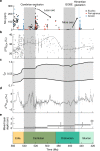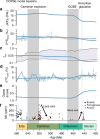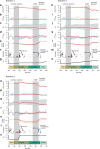Early Palaeozoic ocean anoxia and global warming driven by the evolution of shallow burrowing
- PMID: 29967319
- PMCID: PMC6028391
- DOI: 10.1038/s41467-018-04973-4
Early Palaeozoic ocean anoxia and global warming driven by the evolution of shallow burrowing
Abstract
The evolution of burrowing animals forms a defining event in the history of the Earth. It has been hypothesised that the expansion of seafloor burrowing during the Palaeozoic altered the biogeochemistry of the oceans and atmosphere. However, whilst potential impacts of bioturbation on the individual phosphorus, oxygen and sulphur cycles have been considered, combined effects have not been investigated, leading to major uncertainty over the timing and magnitude of the Earth system response to the evolution of bioturbation. Here we integrate the evolution of bioturbation into the COPSE model of global biogeochemical cycling, and compare quantitative model predictions to multiple geochemical proxies. Our results suggest that the advent of shallow burrowing in the early Cambrian contributed to a global low-oxygen state, which prevailed for ~100 million years. This impact of bioturbation on global biogeochemistry likely affected animal evolution through expanded ocean anoxia, high atmospheric CO2 levels and global warming.
Conflict of interest statement
The authors declare no competing interests.
Figures





References
-
- Aller, R. C. The Influence of Macrobenthos on Chemical Diagenesis of Marine Sediments (Yale University, New Haven, CT, USA, 1977).
-
- McIlroy D, Logan Ga. The impact of bioturbation on infaunal ecology and evolution during the Proterozoic-Cambrian transition. Palaios. 1999;14:58–72. doi: 10.2307/3515361. - DOI
-
- Kristensen E, et al. What is bioturbation? the need for a precise definition for fauna in aquatic sciences. Mar. Ecol. Prog. Ser. 2012;446:285–302. doi: 10.3354/meps09506. - DOI
-
- Herringshaw LG, Callow RHT, McIlroy D. Engineering the Cambrian explosion: the earliest bioturbators as ecosystem engineers. Geol. Soc. Lond. Spec. Publ. 2017;448:369–382. doi: 10.1144/SP448.18. - DOI
Publication types
Grants and funding
- PhD Aspirant/Fonds Wetenschappelijk Onderzoek (Research Foundation Flanders)/International
- Academic Fellowship/University of Leeds/International
- ERC Grant 306933/EC | European Research Council (ERC)/International
- VICI grant 016.VICI.170.072/Nederlandse Organisatie voor Wetenschappelijk Onderzoek (Netherlands Organisation for Scientific Research)/International
- NE/P013651/Natural Environment Research Council (NERC)/International
LinkOut - more resources
Full Text Sources
Other Literature Sources

